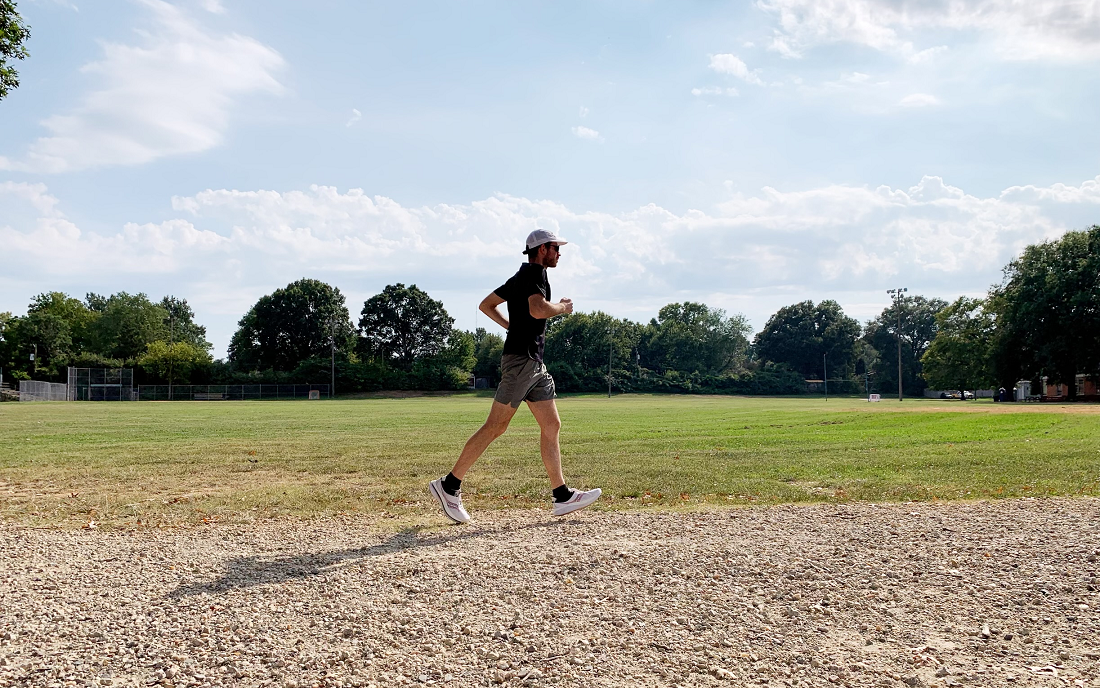Confession: I didn’t read through the Pfitzinger marathon training plan (18/55) from Advanced Marathoning before I decided to use it. I had heard about the well-known plan through running friends and online, but the only two things I knew: it’s an 18-week plan and the peak mileage in a week is 55. What more do I need to know, right?
Well, if you would’ve told me I’d need to do two speed workouts and two long runs a week, I might have chosen a different marathon training plan. Alas, ignorance really is bliss. Blindly following the Pfitzinger marathon training plan has been the most fun I’ve ever had while training. I’m halfway through the 18-week plan I’m using to attempt to go sub-3:00, and with nine weeks in the books, I reflect on my training and what lies ahead for the next nine leading to the 2023 Marine Corps Marathon on October 29 in D.C.
Modifications
With several 50+ mile weeks completed in previous training blocks, I decided to make some changes to the total mileage per week listed in the 18/55 Pfitzinger marathon training plan. I didn’t feel prepared for the 18/70 plan, so I modified the plan to fit somewhere in between the two.
I run six days a week, instead of the four outlined in the plan. Prior to this training block, I had run up to five days a week at the most. The idea of having only one rest day a week seemed daunting, but I’ve found it’s actually easier. When you run 86% of the days in a week, you naturally develop a more consistent routine of running, stretching, and recovery. Eh, who am I kidding? I’m breaking the Second Commandment of Running: I don’t spend nearly as much time as I should on stretching or recovery. But I’ve certainly got the running part down. One out of three ain’t bad?
Additionally, I’ve surpassed the 55-mile/week maximum outlined in the plan. I’ve exceeded 60+ mile weeks for three of the first nine weeks. Of course, I was sure to gradually build up to that level of mileage. Reaching the 60-mile/week threshold for the first time was a significant milestone.
Speed work
I started taking speed work seriously in 2022, so, two speed workouts in a week came as quite the shock. Each week there’s a workout with strides and a lactate threshold workout of a 10-mile run with six miles at 15k/half marathon pace. I typically only race marathons so I don’t have a designated pace for other distances. With a marathon goal of 6:50/mile, I chose a half marathon pace of 6:40 for these workouts. While it hasn’t been easy hitting this pace in the intense Virginia humidity this summer, I’ve greatly enjoyed the challenge and the gratification after my workouts. They’ve become the highlights of my training week.
Tempo runs have always been my favorite speed workout, but strides are quickly making their way to the front of the pack. It doesn’t hurt that they’re much easier (and shorter) than tempo runs. I’m modifying the recommended strides (10 x 100 m) by doing 15 x 20-second strides. Prior to this training plan, I had never run strides. Honestly, I didn’t even know what strides were. Same goes for lactate thresholds.
Long runs
I’ve always looked forward to my weekly long run, but having to do two in a 7-day span made me feel uneasy at first. But, as my mileage increased, so did my fitness. It’s always exciting when you start to hit your stride during marathon training. This week, I had 14- and 16-mile runs and the prior week called for 12- and 20-milers. It’s crazy to consider those two runs comprise almost half of my total weekly mileage!
The next nine weeks
Looking ahead to the second half of the Pfitzinger marathon training plan, I see what looks like a compound of chemical elements or a math formula: VO₂ max. It won’t come as a surprise that science and math were my worst school subjects. As a running junkie, I’ve heard the term used, but wasn’t aware of the specific meaning. Thanks to the Cleveland Clinic, I now know it refers to oxygen uptake. Specifically, it’s how much oxygen your body absorbs and uses while exercising. V is for volume, O2 is for oxygen and max is for maximum. Science!
That’s all well and good, but I have no idea what that means before my outsoles hit the road for an 8 miler with 5 x 600 m at 5K race pace, jogging 50 to 90% interval time between. Excited to find out! There are a few 8k-15k tune-up races outlined in the plan, but with no races marked on my calendar, I’ll likely create my own solo “races.”
As my mileage continues building, I may reach a 70-mile peak. While marathon training demands a lot from the body, one thing has become clear during this training block: my mind is just as crucial. There are many days I doubt I’ll hit my target pace in speed workouts. Or when I don’t think I can end the 65-mile week with a 20-mile long run. Or days I simply don’t want to step outside my front door.
But, I’ve found it helps to take each workout day by day and each run step by step. That may sound corny (it really does), but it’s what works for me. I never look too far ahead in any one week — or run — for fear of being overwhelmed. Like I said, ignorance is bliss.









Wow! Impressive. Interesting to hear what goes into a marathon under-3:00 training plan! Thanks for sharing!